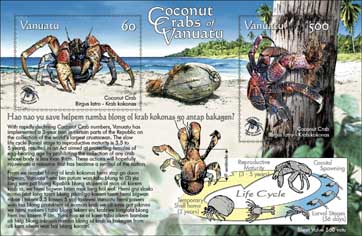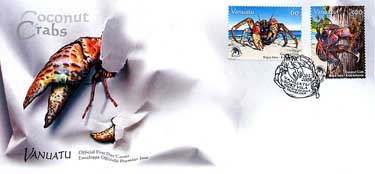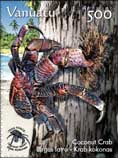Coconut Crab
-
Denominations :60 and 500 vatu
-
Designer :Lucas Kukler, Nairobi, Kenya
-
Mini Sheet size :115mm x 75mm horizontal
-
Paper :104g, Non phosphor, tasteless tropical gum stamp paper
-
Perforation Gauge :13.33 x 13.60
-
Period of Sale :20 February 2008 for a period of 2 years.
-
Printer :Southern Colour Print, Dunedin New Zealand
-
Process :Offset Litho
-
Stamp Size :1 horizontal and 1 vertical stamp, 40mm x 28mm
Description
![]()

The life cycle of the Coconut Crab Birgus latro is extremely drawn out which causes the species to re-populate slowly. Phase one sees the female crabs travel to the coast to spawn. Four to five larval stages follow, taking 28 days in the ocean, after which the developing crab spends a further 28 days on the ocean floor. The next stage is to come ashore and find an empty shell to hide in. They remain in this temporary housing for 1-2 years and then travel inland where they tunnel underground to a depth of 50mm. In yet another home, the exoskeleton becomes brittle and is discarded and the crab becomes immobile. The crab then eats its old shell to re-absorb minerals while a new shell develops over a 4-week period. The crab can then finally leave its burrow but reproduction cannot occur until they mature between 3.5 and 5 years. 
 This enormous crab which can weigh nearly 9 pounds and live 60 years, has developed much to adapt to its conditions: climbing skills to fetch food from tree tops; digging skills to burrow underground and into tree trunks to hide; gills to survive in water, or to drink a little saltwater to maintain its body salt. They are herbivorous feeding mainly on dry coconut flesh (by cracking open coconut shells with their powerful claws), dead fruits and leaf but have also been observed eating dead animal carcasses.
This enormous crab which can weigh nearly 9 pounds and live 60 years, has developed much to adapt to its conditions: climbing skills to fetch food from tree tops; digging skills to burrow underground and into tree trunks to hide; gills to survive in water, or to drink a little saltwater to maintain its body salt. They are herbivorous feeding mainly on dry coconut flesh (by cracking open coconut shells with their powerful claws), dead fruits and leaf but have also been observed eating dead animal carcasses.
The crab population has shrunk throughout its range due to habitat depletion, collecting for food and by introduced animal enemies such as pigs. With rapidly declining Coconut Crab numbers, Vanuatu has implemented a 3-year ban in certain parts of the Republic, on the collection of the world’s largest crustacean. The slow life cycle resulted in an Act aimed at protecting females of egg-bearing age, by prohibiting the collection of any crab whose body is less than 9cm. In length. These actions will hopefully rejuvenate a resource that has become one of the symbols of the nation.
 The Wantok Environment centre in Santo has received over 1.6M vatu to fund the next phase of “Opereisen Seven Krab Kokonas” in Sanma Province. The Sanma Coconut Crab Taskforce will use the funds to conduct awareness-raising activities, scientific studies and stakeholder consultations aimed at conserving the rapidly declining stocks.
The Wantok Environment centre in Santo has received over 1.6M vatu to fund the next phase of “Opereisen Seven Krab Kokonas” in Sanma Province. The Sanma Coconut Crab Taskforce will use the funds to conduct awareness-raising activities, scientific studies and stakeholder consultations aimed at conserving the rapidly declining stocks.
The gathering of Coconut Crabs is not illegal but there is a quota allocation and closed seasons which everyone is asked to obey. "In Torba Province," the Vanuatu Fisheries Department says of the region, which includes Vanuatu's northernmost Banks and Torres islands, "collecting crabs is one of the few ways in which people can get an income. Management and sustainability of this resource is vital." 
Vanuatu Post is proud to support the efforts being made to ensure the long-term survival of the Coconut Crab in Vanuatu and releases this stamp issue to help raise awareness of this conservation initiative.


